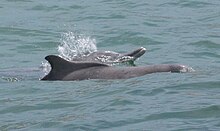Menai Bay Conservation Area
In addition to controlling illegal fishing, MBCA's alternative initiatives have included bee keeping, mangrove replanting, tree nurseries and tourism.
The villagers who were earlier killing these animals for food are now deriving economic benefits working with their boats as guides to show the dolphins to visitors.
The open sea in the MBCA is reach in phytoplankton and zooplankton, which serve as food for sardines and small pelagic fish having commercial value for local firshmen.
In order to control these activities, local villagers started operating patrols in the fishing zones, such as in Fumbal peninsula, with proactive support of the Commission of Natural Resources.
[7] In the early 1990s, the heavy degradation of the area is confirmed by Institute of Marine Science (IMS) and WWF establish their office in 1990 in Zanzibar.
[3] The historical practices in the area consisted of cultivation of Eucheuma seaweed and use of Ulva and Enteromorpha species as fish baits; green algae was also collected for medicinal use.
USAID supported pilot projects in three islands where seaweed grew densely, given the protection provided at these locations from waves.
They were also developed as demonstration farms to provide training and extension services to the local fishermen in enhancing the quality of dry seaweed.
Commercial collection of seaweed were also started by private companies, which contributed nearly 20% to the island's earning and employed a significant fraction of women.
[10] However, a "monopsonyl arrangement" of farming controlled by individual buyers to buy the yield at their predetermined rates, on the basis of the initial supply of materials such as lines and seaweed seedlings to the producers, is in vogue.
Other improvements were establishment of a radio network, providing environmental education to the villagers and community members assisting in legal proceeding in the court against unlawful activities.
[7] In 2003, under a grant received from the McKnight Foundation, instituted bivalve farming in the Fumba Peninsula of the project area to increase resource base of the intertidal zone and of wild stocks of oysters, isognomon, mussels and clams.


